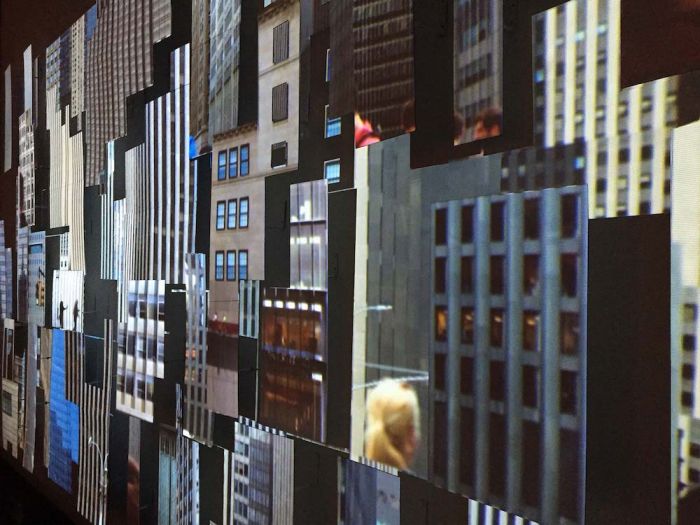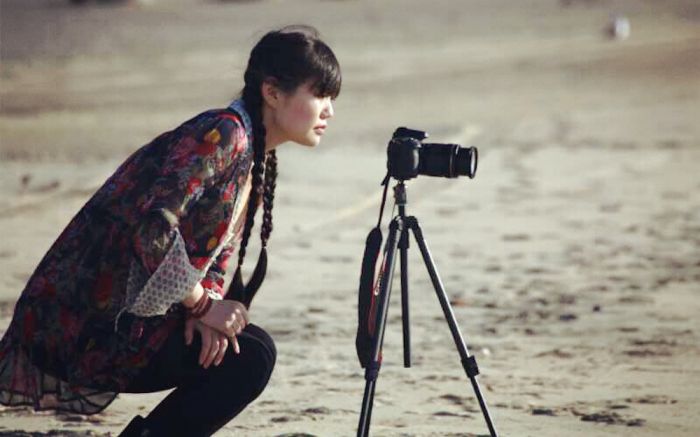Chinese artist Yuge Zhou’s upbringing was unique to say the least. As the singer of a popular children’s television show theme song, Yuge was surrounded by music and the arts from an early age. After studying first in China, then in the United States (at The Art Institute of Chicago, to be specific), Yuge is using her cultural influences as a medium, by transforming perspectives and exploring cities like never before. Using her education in science and engineering, Yuge utlizes incredible artistic skill to craft video collages, creating "visual poetry" in urban dispositions. These installations are not only entrancing videos, relief sculptures and sculptural maps examining humans and their interactive surroundings, but they also have a strong, electric emphasis on cultural universality. Yuge’s work has appeared in some of the world’s most elite museums and galleries, and is currently showing her new series, Midtown Flutter, at the Elmhurst Art Museum.
What initially drew you to art?
I’ve always been drawn to creating beautiful things since I was a child. Both of my parents are musicians in China, so they’ve been very attentive to my creative urge. I took traditional Chinese brush painting and piano lessons throughout my childhood and early teenage years. As I grew older, like most Chinese teenagers, I was advised to be a “good” student in more traditional subjects, such as mathematics and physics. I ended up getting into a prestigious engineering college in Beijing and then started my journey in the States by entering the Master of Science program at Syracuse University. Coming to America was a critical first step for me as an artist. Syracuse and its close proximity to metropolitan cities like New York and Boston influenced me like nothing else. I became deeply intrigued with American urban life, how people live in a city, the relationship people have with each other in a city, as well as the kind of relationship people have with both the man-made and natural aspects of the environment. I once again had the urge and freedom to create, so I started to take art lessons at a local college.
How does your early career in music and singing relate to your current career as an artist? Tell us about the famous song.
I was six years old when I was invited to be the lead singer for a television show Little Dragon Boy. The series turned out to be one of the most beloved children’s TV shows in Chinese history, and the six songs I sang for the show became an overnight sensation.
The countless performances followed by the success of the show were a blur to me, but what always stayed in my heart was the overwhelming joy I saw when people responded to the song and my singing. It was not until I started making art in Syracuse did I again feel the joy of sharing a visual diary that invites people to perceive reality in different ways. It is what motivates me as an artist.
You were born in China, and now live in the U.S., how do you think living in different cultures has informed your artwork?
First of all, my work is meditative, rooted in Chinese philosophy that seeks to find the tranquility beneath the turbulence of daily life. Second, my aesthetic is influenced by traditional scroll paintings which always illustrate a compressed narrative, multiple events happening at the same time. Likewise, I use collage technique to create moving images that progress through time and space and are combined together to create an uncanny perspective that never loses sight of the individual components.
Initially, the American cities with their towering structures, noise, activity, as well as their population density and anonymity, inspired me to reinterpret the American scene from the perspective of an outsider. But the longer that I’ve lived here, I have come to appreciate a universal condition pulsing through the cities that ties all humanity together, not separates them, regardless of where they are living. This universality is what I want to acknowledge, and ultimately, celebrate in my work.
How would you describe your art?
My artwork is comprised of video collages and sculptural video installations that portray "urban dispositions" and explore the complex interactions between humans and their environment. I use my camera to document ritualistic moments of urban life and rearrange and assemble documentation into a metaphorical cityscape. Most of all, my work comes out of the scenes that play out by chance in front of my camera. When these scenes aggregate, a rhythm emerges with a deliberate structure and shape, an essential rhythm that in some way defines a place.
My installation itself uses techniques like wall relief and projection mapping to enhance these framed glimpses, as well as emphasizing the physicality of digital video. This approach is inspired by the concept of architectural relief, a technique where the sculpted elements remain attached, but raised above the background plane. Audiences experience a gradual shift in the appearance and depth of the installation from a flat image to a three-dimensional view with protruding geometric shapes.
How would you say your art has changed over the years?
I started by creating paper collages that explored design and abstract patterns by drawing inspiration from my surroundings. At the same time, I photographed daily rituals embedded in micro-narratives and architectural elements. About four years ago, I moved to video art because I wanted to explore the concept of time in relation to space within the context of my work. While keeping my focus on the urban environment and experience, I expanded my vision of what a city is from the formal qualities of its architecture to the actions of its people—the collective tapestry of its citizenry. For my recent large scale installation projects, I not only create the videos but I also construct sculpted wall relief panels to give a physicality and depth to otherwise flat and ephemeral digital images.

Describe Midtown Flutter and what it means.
Midtown Flutter is part of The Humors, a video collage and installation series I’ve been working on this year. I shot a variety of architecture in midtown Manhattan, allowing passersby to interrupt the scene. By selecting and then composing the video footage according to the formal qualities of the architecture within the scene, the architecture in turn dictates the patterns and flow of the pedestrians. Midtown becomes a flattened, uniform construct for this play of texture, rhythm and interruptions.
Midtown Manhattan is one of the most iconic places in the world, where tourists and working New Yorkers occupy the same space and co-mingle. It represents the brief, fragmented instances and moments in city life when somebody walks into our life and then leaves. We don’t know their stories and we barely see them, but it’s all part of the city experience and the mythology of New York. I think a lot of people come to New York because of this mythology.
What artists have most influenced you and your work?
Structural film is particularly interesting to me because it emphasizes structure, logic and constraints to create composition, to sequence elements and to engage with time. This is evident in both Michael Snow’s and Hollis Frampton’s work. Experimental filmmaker James Benning’s work also emphasizes the aspect of time in a very subtle way with his signature long takes. I had an opportunity to study with James a few years ago, which really solidified the path of my work. My other influences include documentary photographers like Walker Evans who captured the American vernacular of ordinary life and indigenous architecture through his lens, and some of the British painters like David Hockney and Ben Nicholson.
What are your hopes and plans for the future of your work?
In the short term, I hope to expand certain thematic and aesthetic avenues in The Humors series. As I travel to more cities, more opportunities of expression present themselves, sometimes completely by surprise. I am also expanding the scope of my installation reliefs and presenting these in venues at a more international level.
In a broader context, video and new media art is still a challenging art form to be presented; there are a lot of art venues that do not have the means and/or expertise to install, manage, and conserve video installation art. I want to keep exploring how the moving image can be experienced, but also how it can exist in more places. A lot of video art is very accessible to a general public, but just isn’t in front of their eyes.
What are you currently working on?
I’m currently working on a quartet video series entitled The Humors that is inspired by the Ancient Greek philosophy of four temperaments or "humors": the sanguine, choleric, melancholic and phlegmatic. The Greeks believed these humors color all of creation. Urbanity is part of this creation, and I believe it also embodies versions of these dispositions. This series suggests urban behaviors and relationships, those of people and of the built environment.
Below are the four individual videos that comprise “The Humors” series:
Green Play
:
Midtown Flutter
:
Deep Ends







